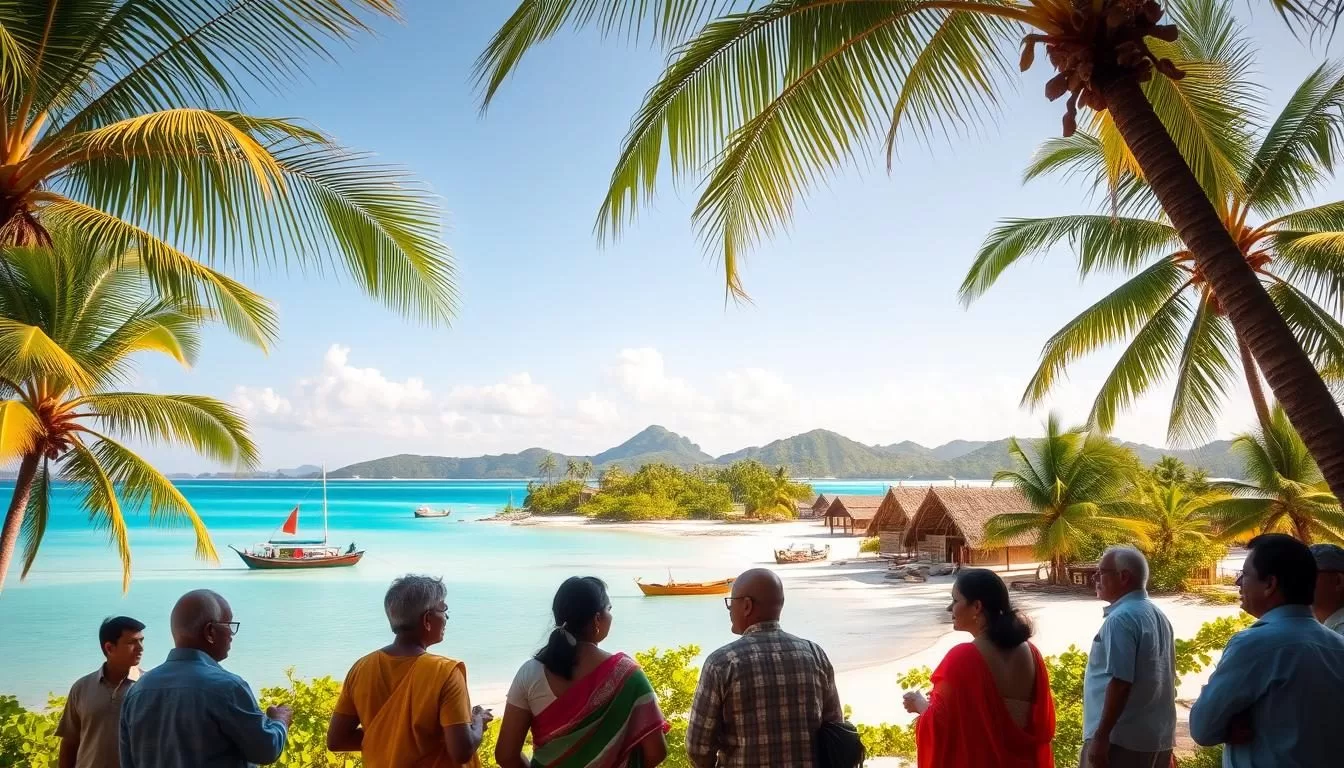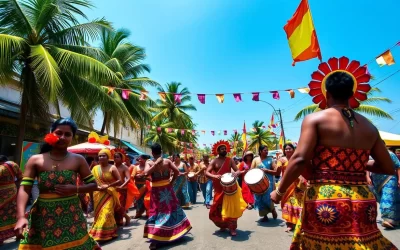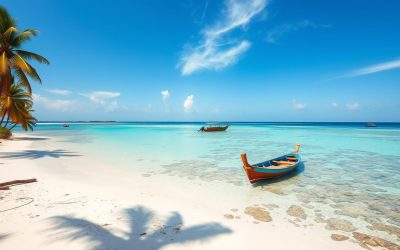You are about to explore the fascinating world of languages in Lakshadweep, a union territory comprising 36 islands in the Arabian Sea.
This archipelago, despite its small size, boasts a rich linguistic heritage shaped by its geographic isolation and historical influences.
As you delve into the linguistic landscape of these islands, you’ll discover the unique cultural identity reflected in the languages spoken here.
The languages spoken in Lakshadweep are not just a means of communication but also a reflection of the territory’s history and cultural diversity.
The Linguistic Landscape of Lakshadweep
The linguistic landscape of Lakshadweep is a complex tapestry woven from threads of migration, religion, and local traditions. As you delve into the islands’ history and culture, you’ll uncover the factors that have shaped the languages spoken here.
Geographical Overview of Lakshadweep
Lakshadweep, located off the southwest coast of India, is an archipelago of 36 islands. Most inhabitants are descendants of migrants from the Malabar Coast who arrived before the 7th century CE. This migration has significantly influenced the linguistic and cultural identity of the islands.
Cultural and Demographic Context
The islands are predominantly Islamic, with the religion playing a crucial role in shaping the local culture and languages. Despite the predominance of Islam, vestiges of Hindu influence are evident in the matrilineal kinship system. The economy, primarily based on fishing and coconut cultivation, has also contributed to the development of specialized vocabulary related to these activities.
The unique demographic composition of Lakshadweep has fostered a diverse linguistic landscape. You’ll find that the people of Lakshadweep have developed distinct dialects and languages, reflecting the various cultures that have influenced the islands over the centuries.
English: The Official Language of Lakshadweep
English is not just a language in Lakshadweep; it’s a bridge that connects the island’s governance and educational systems to the rest of India. As the official language, it plays a crucial role in the administration and education of this island union territory.
Administrative Use of English
In Lakshadweep, English is used extensively in official communications and documentation. Government employees are required to have proficiency in English to ensure efficient administrative functioning. The jurisdiction of the Kerala High Court over Lakshadweep also necessitates the use of English in legal proceedings, further emphasizing its importance.
| Domain | Usage of English |
|---|---|
| Administration | Official communications, documentation |
| Legal System | Proceedings in the Kerala High Court |
| Education | Medium of instruction at higher levels |
English in Education and Government
English serves as a vital medium of instruction in Lakshadweep’s educational institutions, particularly at higher levels. The college in Lakshadweep is affiliated with the University of Calicut, further integrating the island’s education system with mainland India. The high literacy rate in Lakshadweep, over 90%, is a testament to the effectiveness of English education over time.
You can see how English has contributed to the high literacy rate and facilitated connections with mainland India’s educational system. Government initiatives have supported the use of English, ensuring that the population remains proficient in it for official purposes.
Malayalam and Its Dialects in Lakshadweep
In Lakshadweep, Malayalam stands out as a widely spoken language, with unique dialects emerging due to the islands’ geographical isolation. As you delve into the linguistic landscape of these islands, you’ll discover the significant role Malayalam plays in connecting the communities across the archipelago.
Malayalam as a Link Language
Malayalam serves as a crucial link language in Lakshadweep, facilitating communication among the islanders. It is the language spoken by the majority of the population, enabling them to interact with each other and with the outside world. The widespread use of Malayalam has contributed to the cultural and social cohesion of the island communities.
As a link language, Malayalam has become an integral part of daily life in Lakshadweep. It is used in various contexts, including administration, education, and social interactions. The language has adapted to the local culture, incorporating elements that are unique to the islands.
Jeseri: The Distinctive Dialect of Lakshadweep
One of the most fascinating aspects of Malayalam in Lakshadweep is the Jeseri dialect, also known as Dweep Basha. This distinctive dialect is spoken widely across the inhabited islands of Lakshadweep. Jeseri has evolved separately from mainland Malayalam due to the islands’ isolation, developing unique vocabulary and pronunciation patterns.
The Jeseri dialect is characterized by its rich oral tradition, which has been passed down through generations. Although it didn’t have a standardized written form until recently, Jeseri remains an essential part of the islanders’ identity. The dialect includes specific linguistic features that distinguish it from standard Malayalam, particularly in vocabulary related to marine life, fishing, and island living.
| Feature | Jeseri Dialect | Standard Malayalam |
|---|---|---|
| Vocabulary for Marine Life | Unique terms adapted to island context | Standard terms |
| Pronunciation | Distinctive pronunciation patterns | Mainland pronunciation |
| Cultural References | Rich in island-specific cultural references | General cultural references |
Jeseri is not just a dialect; it’s an important marker of local identity for the islanders, distinguishing them from mainland Malayalam speakers. As you explore the linguistic diversity of Lakshadweep, you’ll find that Jeseri is a vital part of the cultural heritage of the islands.
Dhivehi (Mahl): The Language of Minicoy Island
Minicoy Island, part of the Lakshadweep archipelago, is home to a unique linguistic heritage – the Dhivehi language, also known as Mahl. This language is a significant part of the island’s cultural identity and distinguishes it from other islands in Lakshadweep.
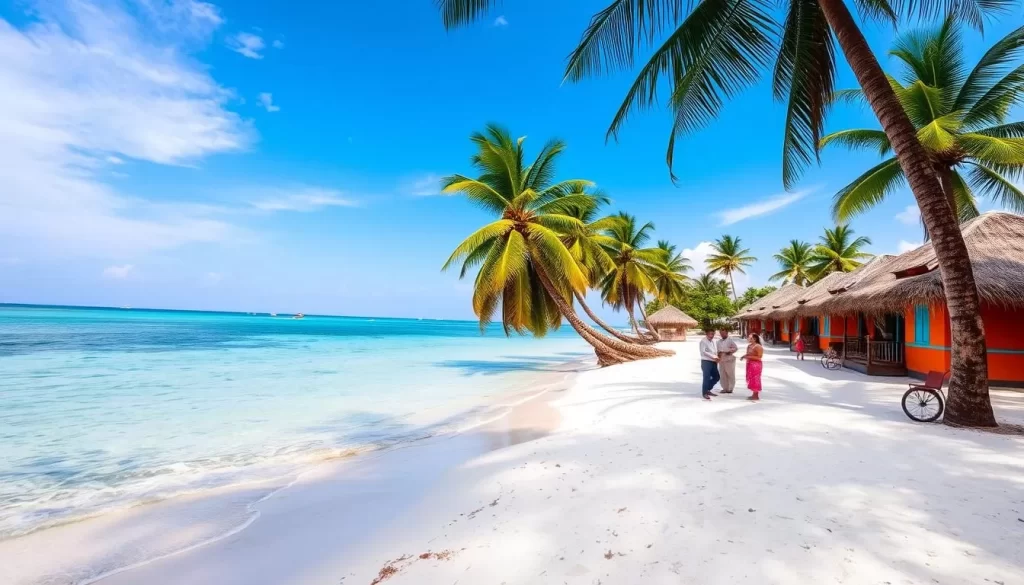
Historical Connection to Maldivian Culture
The Dhivehi language spoken on Minicoy Island has historical ties to the Maldivian culture, reflecting the geographical proximity and historical interactions between Minicoy and the Maldives. Although Dhivehi in Minicoy has developed distinct characteristics due to its isolation and the influence of other languages spoken in Lakshadweep, it retains a strong connection to its Maldivian roots. This connection is evident in the language’s script, vocabulary, and certain cultural practices.
The Thaana script, used for writing Dhivehi, is a unique aspect of this language, differing from the scripts used for other languages in Lakshadweep. This script is not only a means of written communication but also a symbol of the cultural heritage of Minicoy Island.
Current Usage and Distribution
Dhivehi is spoken by approximately 14% of Lakshadweep’s total population, according to the 2011 census, primarily on Minicoy Island. It is used in various domains of daily life, including at home, in community gatherings, and during cultural events. Despite the influence of more widely spoken languages in the region, efforts are being made to preserve Dhivehi, recognizing its importance to the cultural identity of Minicoy Island.
The language’s survival is a testament to the island’s cultural resilience and the community’s efforts to maintain its unique linguistic heritage amidst the broader linguistic landscape of Lakshadweep. As you explore the linguistic diversity of the Islands Lakshadweep, the distinctiveness of Dhivehi on Minicoy Island stands out, highlighting the rich tapestry of languages within this Indian archipelago.
Official and Widely Spoken Languages in Lakshadweep: Island-by-Island Analysis
You can explore the diverse linguistic heritage of Lakshadweep by examining its various islands. The Lakshadweep archipelago, comprising the Amindivi and Laccadive Islands, among others, presents a fascinating case of linguistic diversity.
Languages in the Amindivi Islands
The Amindivi Islands, which include Amini, Kadmat, and Bitra, have a distinct linguistic profile. Malayalam is widely spoken across these islands, serving as a link language among the inhabitants. The dialect spoken here is closely related to the Jeseri dialect, which is unique to Lakshadweep.
Inhabitants of these islands also use English for administrative and educational purposes. The prevalence of English is notable, especially among the younger population and those involved in the tourism sector.
| Island | Primary Language | Secondary Language |
|---|---|---|
| Amini | Malayalam | English |
| Kadmat | Malayalam | English |
| Bitra | Malayalam | English |
Languages in the Laccadive Islands
The Laccadive Islands, including Kavaratti, Andrott, Agatti, and Kalpeni, exhibit a slightly different linguistic landscape. While Malayalam remains a dominant language, the Jeseri dialect spoken here has unique characteristics and vocabulary.
The influence of Arabic on the local dialect is evident due to historical trade connections. Kavaratti, being the administrative center, shows a higher prevalence of English usage, particularly in official and educational contexts.
- The Jeseri dialect in Laccadive Islands has distinct expressions.
- Arabic influence is noticeable in the local language.
- English is more prevalent in Kavaratti.
Historical Evolution of Languages in Lakshadweep
As you explore Lakshadweep’s history, you’ll discover the significant role of linguistic evolution. The islands have witnessed a rich tapestry of cultural and linguistic influences over the centuries.
Pre-Islamic Linguistic Influences
Before the advent of Islam, Lakshadweep’s linguistic landscape was shaped by various factors. The geographical location of the islands facilitated interactions with different cultures, contributing to the linguistic diversity. You can observe how the early linguistic influences were largely driven by trade and cultural exchanges.
The pre-Islamic era saw the presence of various languages and dialects, laying the groundwork for the linguistic diversity seen today. Although specific details about the pre-Islamic languages are scarce, it’s understood that the islands had interactions with the mainland and other island cultures, leading to linguistic exchanges.
Impact of Islamic Culture on Language Development
The introduction of Islam in the 7th century CE, attributed to Ubaidullah, marked a significant turning point in the linguistic history of Lakshadweep. As Islam became predominant, Arabic became an important language for religious purposes, influencing local languages through loanwords and expressions.
The adoption of the Arabic script for writing local languages, especially for religious texts, was a significant development. Islamic education systems introduced Arabic language learning, which continues to influence the linguistic landscape. You can see how the predominance of Islam shaped the development of local languages by introducing new concepts, terms, and writing systems.
| Time Period | Linguistic Influence | Key Features |
|---|---|---|
| Pre-Islamic Era | Various cultural exchanges | Diverse linguistic elements |
| 7th Century CE onwards | Introduction of Islam and Arabic | Arabic script, loanwords, religious terminology |
| Over time | Continued Islamic influence | Evolution of local languages with Islamic terms |
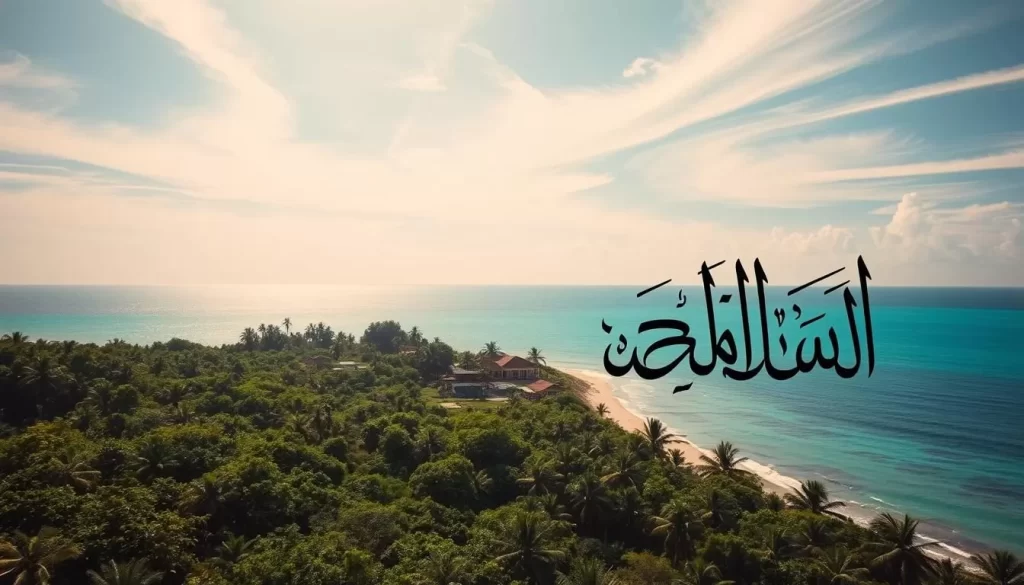
Script and Writing Systems in Lakshadweep
You will find that Lakshadweep employs multiple scripts, reflecting its cultural diversity. The islands’ unique geographical location and historical context have contributed to the development of various writing systems.
Malayalam Script Usage
The Malayalam script is predominantly used in Lakshadweep for administrative and educational purposes. As the official language of the union territory, Malayalam is widely used in government offices, schools, and public communications. The script is an essential part of the cultural identity of the islands, and its usage is promoted through various government initiatives. The Malayalam script has undergone several changes over the centuries, influenced by the cultural and linguistic evolution of the region.
| Script | Usage | Significance |
|---|---|---|
| Malayalam | Administrative, Educational | Cultural Identity |
| Arabic | Religious | Islamic Heritage |
Arabic Script and Its Influence
The Arabic script has historical and continuing importance in Lakshadweep, particularly in religious contexts. Traditionally, Arabic was used for writing religious texts, and sometimes it was adapted for writing local languages in a system similar to the Arabi-Malayalam used in Kerala. The teaching of the Arabic script is an integral part of religious education in madrasas across the islands. The union territory administration has taken initiatives to preserve traditional Arabic script literacy alongside modern educational systems, recognizing its significance in representing the Islamic heritage of the islands.
The coexistence of multiple writing systems in Lakshadweep reflects the islands’ rich cultural tapestry. As you explore the scripts and writing systems used in Lakshadweep, you will gain a deeper understanding of the islands’ history and cultural identity.
Language and Education in Lakshadweep
As you explore the educational landscape of Lakshadweep, you’ll discover the intricate relationship between language and learning. The government of this union territory has implemented various initiatives to promote literacy across its diverse linguistic population.
Medium of Instruction in Schools
In Lakshadweep’s schools, the medium of instruction is primarily English, alongside Malayalam, which is widely spoken across the islands. The government has ensured that educational resources are available in these languages to cater to the local population. This bilingual approach helps students navigate both local and national contexts effectively.
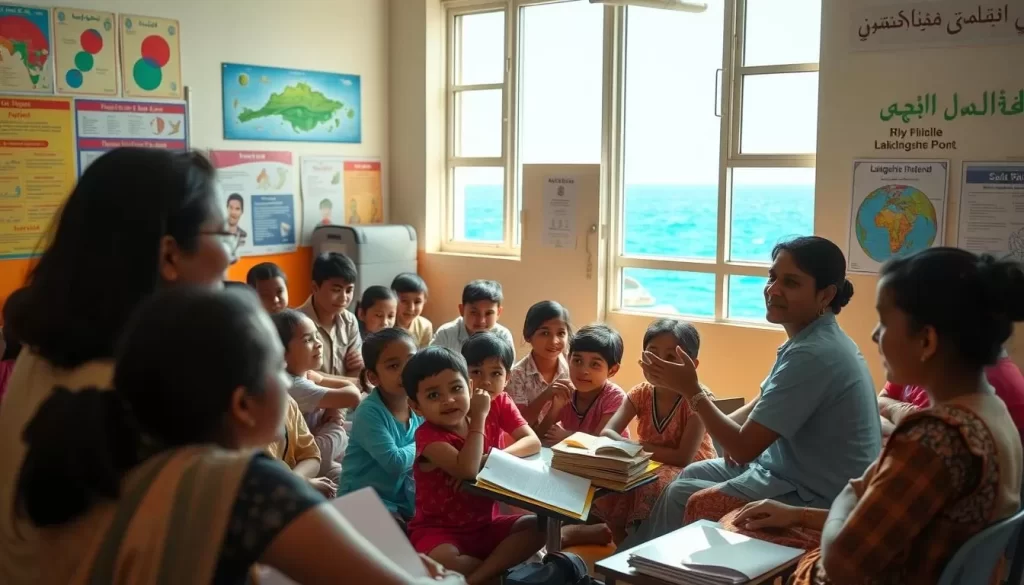
Language Literacy Rates and Challenges
Lakshadweep boasts one of the highest literacy rates among Indian territories, with over 90% of the population literate. However, maintaining literacy in multiple languages, including English, Malayalam, and local dialects, poses certain challenges. The territory faces issues in smaller islands where educational resources are limited. To address these challenges, digital technology is being increasingly utilized to enhance language education.
| Island | Literacy Rate | Primary Languages |
|---|---|---|
| Minicoy | 92% | Mahl, Malayalam, English |
| Androth | 91% | Malayalam, English |
| Kavaratti | 93% | Malayalam, English |
These efforts highlight the government‘s commitment to improving educational outcomes across the union territory, ensuring that linguistic diversity becomes a strength rather than a hindrance.
Language and Cultural Identity in Lakshadweep
Language plays a pivotal role in shaping the cultural identity of the people of Lakshadweep. The islands’ unique linguistic heritage is a crucial aspect of their distinctiveness from mainland populations. You will discover how the languages and dialects spoken in Lakshadweep are deeply connected to the daily lives and traditions of its inhabitants.
Role of Language in Preserving Island Heritage
The rich oral traditions of Lakshadweep, including folk songs, poetry, and storytelling, are specific to the languages and dialects spoken on the islands. These traditions are passed down through generations within family units, playing a vital role in preserving the island’s heritage. The specialized vocabulary related to fishing, boat-building, and navigation reflects the islanders’ deep connection to the sea.
Language-Based Cultural Practices and Traditions
Language-specific cultural practices are an integral part of life in Lakshadweep. For instance, traditional fishing terminology and techniques are handed down through family lines, highlighting the importance of language in maintaining cultural continuity. Moreover, cultural festivals and celebrations feature language-specific performances that are increasingly being showcased for tourism purposes, introducing these unique cultural practices to a wider audience.
You will understand how these cultural practices, tied closely to the languages of Lakshadweep, contribute to the islands’ distinct identity and the things that make them special.
Language Policies and Government Initiatives
You can observe the impact of government language policies on the daily lives of the people in Lakshadweep. The union territory’s linguistic diversity is supported through various government initiatives. These policies play a crucial role in shaping the cultural identity of the territory.
Official Language Policies
The government of Lakshadweep has implemented official language policies that recognize the importance of English as the administrative language. English is widely used in government offices, education, and official communications. This policy ensures that the territory remains connected with the rest of the country and facilitates administrative efficiency.
The role of Malayalam is also significant, given its widespread use among the population. The government supports the use of Malayalam in local contexts, promoting cultural heritage and community engagement. This dual approach to language policy helps in maintaining a balance between national integration and local identity.
Preservation Efforts for Local Dialects
Efforts to preserve local dialects, such as Jeseri and Mahl, are underway, driven by both government initiatives and community efforts. Cultural institutions and educational bodies are working together to document these dialects, creating dictionaries, grammars, and teaching materials. This not only helps in preserving the linguistic heritage but also promotes awareness among the younger generation about their linguistic roots.
Community-based initiatives, often centered around family and kinship networks, complement the government’s efforts. These initiatives are crucial in ensuring the continued use of local dialects in daily life. Moreover, the incorporation of local languages into tourism promotion by the union territory government highlights the linguistic diversity, enriching the cultural experience for visitors.
| Language/Dialect | Preservation Efforts | Involvement of Government and Community |
|---|---|---|
| Jeseri | Documentation, creation of teaching materials | High |
| Mahl | Dictionary and grammar development | Moderate |
| Malayalam | Promotion in local contexts | High |

Conclusion: The Future of Languages in Lakshadweep
The future of languages in Lakshadweep is a complex issue, shaped by the island’s unique cultural and geographical context. As a union territory in the Arabian Sea, Lakshadweep’s linguistic landscape is influenced by its proximity to the Kerala coast and the distinct cultural practices of its people.
You’ll gain insights into the current linguistic trends in Lakshadweep and how factors like education, migration, and tourism are influencing language use across the islands. For instance, tourism development is creating both pressures and opportunities for local languages, with visitors increasingly interested in authentic cultural experiences when they visit Lakshadweep.
The use of digital technology is being explored to document and revitalize the languages of Lakshadweep islands, including the distinctive Mahl language of Minicoy Island. This effort is crucial for preserving the linguistic diversity of the region. At the same time, family ties play a significant role in language transmission, with intergenerational language practices determining whether traditional linguistic knowledge about fishing, navigation, and island life will continue.
As you consider the things to know about language use when planning to visit Lakshadweep for tourism purposes, it’s clear that understanding the local linguistic context is essential. The small population and limited land area of Lakshadweep create both challenges and advantages for language preservation compared to larger territories.
The linguistic future of Lakshadweep will likely involve a balance between preservation of traditional languages and adaptation to wider communication needs over time. As the island navigates these changes, it’s essential to recognize the importance of language in preserving the cultural heritage of this fragile archipelago. By supporting language preservation efforts and promoting cultural understanding, you can contribute to the rich linguistic diversity of Lakshadweep.
In conclusion, the future of languages in Lakshadweep is multifaceted, influenced by a range of factors including family language practices, tourism, and technological advancements. As the island looks to the future, it’s clear that a balanced approach will be necessary to preserve its unique linguistic heritage.
The above is subject to change.
Check back often to TRAVEL.COM for the latest travel tips and deals.
